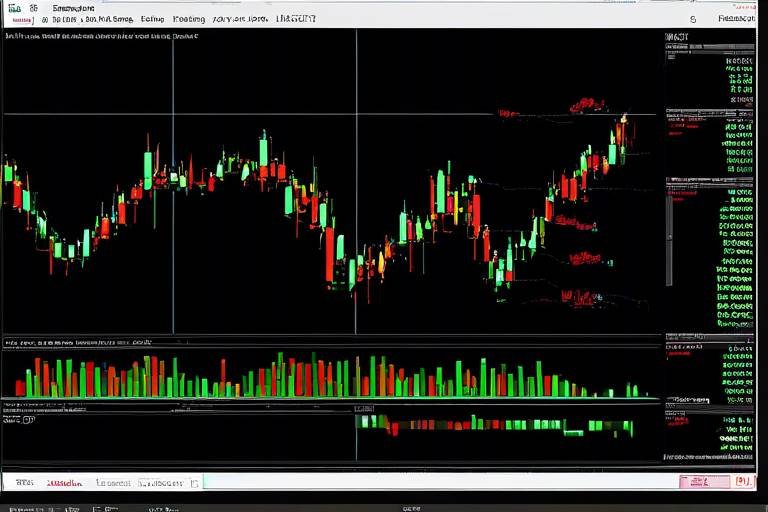How to Navigate Market Uncertainty in Crypto Trading
In the wild world of cryptocurrency trading, uncertainty is as common as the air we breathe. If you’ve dipped your toes into this digital ocean, you know that prices can swing wildly in a matter of minutes. So, how do you keep your head above water when the waves of market volatility crash around you? The answer lies in understanding the nature of this market and employing effective strategies to manage risk. This article dives deep into the strategies and insights that can help you navigate the inherent unpredictability of the crypto market, ensuring that you make informed decisions and mitigate risks.
Market volatility is a significant factor in crypto trading, characterized by rapid price fluctuations. It’s like a roller coaster ride—one moment you’re soaring high, and the next, you’re plummeting down. But what causes these wild swings? Factors such as news events, regulatory changes, and market sentiment play crucial roles. By understanding these causes, traders can anticipate changes and make more informed decisions. For instance, a sudden announcement regarding regulations can send prices tumbling, while positive news can trigger a buying frenzy. Being aware of these dynamics is essential for anyone looking to thrive in this environment.
Implementing robust risk management strategies is crucial for traders. Think of it as wearing a life jacket while navigating choppy waters. It’s all about minimizing potential losses while maximizing opportunities. One of the most effective strategies is diversification. By spreading investments across different cryptocurrencies, you can mitigate the impact of poor performance in any single asset. For example, if Bitcoin takes a dive, a well-diversified portfolio with Ethereum and Litecoin might still keep you afloat.
Diversification is a key strategy for reducing risk. Imagine you’re at a buffet; you wouldn’t fill your plate with just one dish, right? Similarly, spreading your investments across various cryptocurrencies can help balance your portfolio. Here are a few techniques to consider:
- Invest in different sectors: Look for cryptocurrencies that serve various purposes—some for payments, others for smart contracts, and so on.
- Consider market cap: Mix large-cap coins with smaller, emerging ones to balance stability and growth potential.
- Geographic diversification: Explore cryptocurrencies that are popular in different regions to reduce exposure to local market risks.
Choosing the right asset allocation model is essential for balancing risk and reward. Just like a chef needs the right ingredients for a perfect dish, traders need to mix their assets wisely. This subsection examines various models:
| Model | Description | Best For |
|---|---|---|
| Conservative | Focuses on stable, low-risk assets | Risk-averse traders |
| Balanced | Mix of high-risk and low-risk assets | Moderate risk tolerance |
| Aggressive | Heavily invests in high-risk, high-reward assets | High-risk tolerance traders |
Stop-loss orders are vital tools for protecting investments. They act like a safety net, catching you before you fall too far. This part explains how to effectively set and adjust stop-loss levels in response to market conditions. For example, if you buy a cryptocurrency at $100, you might set a stop-loss at $90 to limit your losses. If the price drops to that level, your order will automatically sell, preventing further loss. It’s crucial to adjust these levels as the market fluctuates to stay protected.
Maintaining emotional discipline is critical for successful trading. The crypto market is notorious for triggering emotional responses—fear and greed can lead to impulsive decisions that derail your strategy. This section explores techniques to manage emotions, such as setting clear rules for trading and sticking to them, regardless of market conditions. Think of it as a game; if you let your emotions dictate your moves, you’re bound to lose.
Regular market analysis is essential for informed trading decisions. Knowledge is power, especially in the fast-paced world of crypto. This section covers various analytical approaches, including technical and fundamental analysis, to stay ahead of market trends. Technical analysis involves studying price charts and patterns, while fundamental analysis looks at underlying factors such as technology, team, and market demand. By combining both methods, you can gain a comprehensive understanding of potential market movements.
Technical analysis tools are invaluable for identifying trends and potential price movements. These tools act like a compass, guiding you through the tumultuous waters of trading. Popular tools include:
- Moving Averages: Helps smooth out price data to identify trends.
- Relative Strength Index (RSI): Measures the speed and change of price movements to identify overbought or oversold conditions.
- Bollinger Bands: Provides insights into price volatility and potential price reversals.
Fundamental analysis provides a deeper understanding of market dynamics. It’s like looking under the hood of a car before you buy it. This part discusses how to evaluate the underlying factors that influence cryptocurrency prices and market behavior. Consider aspects like the technology behind the coin, the team’s credibility, and market demand. By conducting thorough research, you can make more informed decisions that align with your trading goals.
A well-defined trading plan is crucial for navigating uncertainty. It serves as your roadmap, guiding you through the twists and turns of the market. This section outlines the key components of an effective trading plan, including goals, strategies, and evaluation criteria. Without a plan, you might find yourself lost in the chaos, making decisions on a whim.
Establishing clear trading goals helps maintain focus and direction. It’s like setting a destination for a road trip; without it, you might end up going in circles. This subsection discusses how to set realistic and achievable goals based on individual risk tolerance and market conditions. For instance, you might aim for a specific percentage return over a year, or simply focus on learning and improving your skills.
Regularly evaluating trading performance is essential for continuous improvement. This section highlights methods for assessing results and adjusting strategies accordingly to enhance future performance. Think of it as a workout routine; if you don’t track your progress, how will you know what’s working? Keep a trading journal to log your trades, emotions, and outcomes. This will help you identify patterns and areas for improvement.
Q: What is the best strategy for trading cryptocurrencies?
A: There’s no one-size-fits-all answer. It depends on your risk tolerance, market knowledge, and investment goals. A combination of diversification, technical analysis, and emotional discipline tends to work well for many traders.
Q: How can I manage my emotions while trading?
A: Set clear trading rules and stick to them. Take breaks when needed, and avoid making impulsive decisions based on fear or greed.
Q: Is it necessary to conduct both technical and fundamental analysis?
A: While it’s not mandatory, combining both methods can provide a more comprehensive view of the market and help you make better-informed decisions.

Understanding Market Volatility
Market volatility is like the wild rollercoaster ride of the financial world, especially in the realm of cryptocurrency. It’s characterized by rapid and often unpredictable price fluctuations that can leave both seasoned traders and newcomers feeling dizzy. But what exactly causes this volatility? Understanding the factors behind these dramatic price swings can give traders a significant edge. Think of it as having a map when exploring uncharted territory; it helps you anticipate the twists and turns that lie ahead.
Several key elements contribute to the volatility seen in the cryptocurrency market:
- Market Sentiment: Emotions run high in the crypto community. News, social media trends, and public opinion can create a frenzy, causing prices to soar or plummet within minutes.
- Regulatory Changes: Cryptocurrencies are often subject to changing regulations across different countries. A new law or policy can drastically affect market stability.
- Market Liquidity: The cryptocurrency market is still relatively young compared to traditional markets. Lower liquidity can lead to larger price swings as fewer trades can impact the market significantly.
- Technological Developments: Innovations and updates in blockchain technology can also influence prices. A major breakthrough can lead to increased investor confidence and buying activity, while security breaches can trigger panic selling.
Understanding these factors is crucial for any trader looking to navigate the stormy waters of crypto trading. It’s not just about knowing when to buy or sell; it’s about anticipating how external events can sway market dynamics. For instance, if a major exchange announces a security breach, traders who understand the implications of such news are better positioned to react swiftly, potentially avoiding significant losses.
Moreover, recognizing patterns in market volatility can help traders develop strategies that align with their risk tolerance. For example, some traders thrive in high-volatility environments, using rapid price movements to their advantage, while others may prefer to wait for more stable conditions. By analyzing historical data and current trends, traders can create a personalized approach to risk management that capitalizes on their strengths.
In conclusion, understanding market volatility is not just an academic exercise; it’s a fundamental part of becoming a successful crypto trader. By grasping the underlying causes of price fluctuations and staying informed about market conditions, traders can make better-informed decisions that enhance their chances of success in this exciting yet unpredictable landscape.
Q: What is market volatility?
A: Market volatility refers to the rate at which the price of an asset increases or decreases for a given set of returns. In the crypto market, it is characterized by rapid and unpredictable price changes.
Q: Why is the cryptocurrency market so volatile?
A: The cryptocurrency market is influenced by factors such as market sentiment, regulatory changes, liquidity, and technological developments, which can all lead to significant price fluctuations.
Q: How can I manage risk in a volatile market?
A: Implementing risk management strategies such as diversification, setting stop-loss orders, and maintaining emotional discipline can help mitigate potential losses in a volatile market.

Risk Management Strategies
When it comes to crypto trading, the phrase "no risk, no reward" often echoes in the minds of traders. However, what many fail to realize is that effective risk management strategies can significantly mitigate potential losses while still allowing for substantial gains. So, how do we navigate this treacherous landscape of volatility? The answer lies in a combination of techniques that not only protect your investments but also enhance your overall trading experience.
One of the most effective strategies is diversification. Imagine you're at a buffet; would you pile your plate high with just one dish? Of course not! You’d want to sample a bit of everything to ensure that if one dish doesn’t sit well with you, the others will still satisfy your appetite. Similarly, by spreading your investments across various cryptocurrencies, you can cushion the impact of a poor performer. For instance, if Bitcoin takes a dip, but your investment in Ethereum remains stable or even rises, you're less likely to feel the sting of that loss.
Another crucial aspect of risk management is asset allocation. This refers to how you distribute your investments among different asset classes. The right balance can help you achieve your financial goals while minimizing risk. For instance, a conservative trader might allocate 70% of their portfolio to stablecoins and 30% to more volatile assets, whereas a more aggressive trader might flip that ratio. Understanding your own risk tolerance is essential in determining the best asset allocation model for you.
| Trader Type | Conservative Allocation | Aggressive Allocation |
|---|---|---|
| Low Risk | 70% Stablecoins, 30% Altcoins | 30% Stablecoins, 70% Altcoins |
| Medium Risk | 50% Stablecoins, 50% Altcoins | 40% Stablecoins, 60% Altcoins |
| High Risk | 30% Stablecoins, 70% Altcoins | 10% Stablecoins, 90% Altcoins |
Additionally, setting stop-loss orders is a vital tool in your risk management arsenal. Think of it as a safety net that allows you to exit a trade when it reaches a specific price point, thereby limiting your losses. This strategy is particularly important in the crypto market, where prices can swing wildly in short periods. By setting an appropriate stop-loss level, you can protect your capital and ensure that you don’t succumb to emotional trading decisions during a downturn.
In summary, navigating the unpredictable waters of cryptocurrency trading requires a solid understanding of risk management strategies. By diversifying your portfolio, carefully allocating your assets, and employing stop-loss orders, you can significantly reduce your exposure to risk. Remember, the goal isn’t just to survive the market’s ups and downs but to thrive amidst the chaos. So, are you ready to take control of your trading journey?
- What is the best way to manage risk in crypto trading?
Implementing strategies such as diversification, asset allocation, and setting stop-loss orders are essential for effective risk management. - How can I determine my risk tolerance?
Your risk tolerance depends on factors like your financial situation, investment goals, and psychological comfort with market fluctuations. Consider consulting with a financial advisor for personalized advice. - Is it possible to eliminate risk in trading?
No investment is without risk. However, effective risk management strategies can help minimize potential losses and enhance your trading experience.

Diversification Techniques
Diversification is often hailed as one of the golden rules of investing, and in the unpredictable world of cryptocurrency trading, it becomes even more crucial. Think of your investment portfolio as a fruit basket; if you only fill it with apples, a bad apple can spoil the entire bunch. By diversifying, you're essentially adding bananas, oranges, and berries, ensuring that even if one type suffers, the others can still thrive. This strategy helps to mitigate risks and smooth out the bumps caused by market volatility.
One effective way to diversify is by investing in a mix of established cryptocurrencies and emerging altcoins. Established cryptocurrencies like Bitcoin and Ethereum tend to have more stability compared to lesser-known altcoins, which can be highly volatile. By balancing these investments, traders can enjoy the potential high returns of altcoins while safeguarding their capital with more stable assets.
Another technique is to diversify across different sectors within the crypto space. For instance, while Bitcoin is primarily viewed as a store of value, Ethereum is known for its smart contract capabilities, and other cryptocurrencies might focus on privacy, scalability, or decentralized finance (DeFi). By spreading your investments across various sectors, you can capitalize on different market trends and innovations:
| Cryptocurrency | Sector | Key Features |
|---|---|---|
| Bitcoin (BTC) | Store of Value | Limited supply, widely accepted |
| Ethereum (ETH) | Smart Contracts | Decentralized applications, NFTs |
| Ripple (XRP) | Payment Solutions | Fast transactions, low fees |
| Chainlink (LINK) | Decentralized Oracles | Connects smart contracts to real-world data |
Additionally, employing a strategy known as the "30% rule" can be beneficial. This rule suggests that no more than 30% of your total investment should be allocated to any single cryptocurrency. This way, even if one asset experiences a downturn, your overall portfolio remains relatively stable. It's also wise to periodically review and rebalance your portfolio to ensure that your investments align with your risk tolerance and market conditions.
In conclusion, diversification techniques are not just a safety net; they are a proactive approach to navigating the unpredictable waters of crypto trading. By spreading your investments across different cryptocurrencies and sectors, you can better manage risk and potentially enhance your returns. So, the next time you consider your investment strategy, remember that a well-diversified portfolio can be your best ally in the volatile world of cryptocurrencies.
- What is diversification in crypto trading? Diversification in crypto trading refers to the strategy of spreading investments across various cryptocurrencies to reduce risk and improve the chances of returns.
- How does diversification help in managing risk? By investing in different assets, if one cryptocurrency performs poorly, the losses can be offset by gains in others, leading to a more stable overall portfolio.
- What percentage of my portfolio should I diversify? A common guideline is to avoid allocating more than 30% of your portfolio to any single cryptocurrency, but this can vary based on individual risk tolerance.
- Should I diversify into altcoins or stick with established cryptocurrencies? A balanced approach that includes both established cryptocurrencies and promising altcoins can be beneficial in maximizing potential returns while managing risk.

Asset Allocation Models
When it comes to navigating the unpredictable waters of cryptocurrency trading, understanding is like having a compass in a storm. These models help traders determine how to distribute their investments across various assets to balance risk and reward effectively. Just like a well-cooked recipe, the right mix of ingredients can make all the difference in the outcome of your trading journey.
There are several asset allocation models, each with its own unique flavor and suitability for different trading styles. For instance, the conservative model focuses on minimizing risk by allocating a larger portion of the portfolio to stable, well-established cryptocurrencies. On the other hand, the aggressive model leans towards high-risk, high-reward assets, which can lead to significant gains but also exposes traders to substantial losses.
One popular approach is the 60/40 model, where 60% of the portfolio is invested in major cryptocurrencies like Bitcoin or Ethereum, while the remaining 40% is spread across smaller altcoins. This strategy allows traders to benefit from the stability of leading cryptocurrencies while still having the potential for high returns from emerging assets. Here's a quick breakdown of how this model might look:
| Asset Type | Percentage Allocation |
|---|---|
| Major Cryptocurrencies | 60% |
| Altcoins | 40% |
Another effective model is the dynamic allocation model, which adjusts the asset distribution based on market conditions. Think of it as a surfer who adjusts their stance on the board depending on the size and direction of the waves. This model requires constant monitoring and analysis but can lead to better returns by capitalizing on market trends.
Ultimately, the choice of asset allocation model should align with your personal trading goals, risk tolerance, and market outlook. A well-thought-out allocation not only mitigates risk but also positions you to seize opportunities when they arise. Remember, while it’s essential to have a strategy, being flexible and willing to adapt to the ever-changing market landscape is equally important.
- What is asset allocation in crypto trading? Asset allocation in crypto trading refers to the strategy of distributing investments across various cryptocurrencies to balance risk and reward.
- How do I choose the right asset allocation model? Choosing the right model depends on your risk tolerance, investment goals, and market conditions. It's important to assess each model's characteristics before making a decision.
- Can I change my asset allocation over time? Absolutely! Regularly reviewing and adjusting your asset allocation is crucial to adapt to market changes and personal financial goals.

Setting Stop-Loss Orders
In the fast-paced world of cryptocurrency trading, is one of the most effective ways to protect your investments. Think of a stop-loss order as a safety net; it automatically sells your asset when it reaches a certain price, preventing further losses. This strategy is crucial, especially in a market known for its wild price swings. However, knowing how to set these orders effectively can be the difference between a minor setback and a significant financial disaster.
First, it's essential to understand the concept of stop-loss levels. These are predetermined price points at which you will exit a trade to limit your losses. The key here is to set these levels based on your trading strategy and risk tolerance. For instance, if you purchase Bitcoin at $50,000 and decide to set a stop-loss order at $48,000, you’re essentially saying, "If the price drops to $48,000, sell my Bitcoin." This approach can help you avoid emotional decisions during market downturns, allowing you to stick to your plan.
When setting your stop-loss, consider the following factors:
- Market Volatility: In a highly volatile market, it may be wise to set your stop-loss further away from the current price to avoid being triggered by normal price fluctuations.
- Support and Resistance Levels: Analyze historical price data to identify key support and resistance levels. Setting your stop-loss just below a support level can provide an extra layer of protection.
- Percentage Method: Some traders use a percentage-based approach, setting their stop-loss at a specific percentage below the purchase price. For example, a 10% stop-loss on a $50,000 investment would trigger a sale at $45,000.
Moreover, it’s important to regularly review and adjust your stop-loss orders as market conditions change. If the price of your asset increases significantly, consider moving your stop-loss order up to lock in profits. This practice, known as a trailing stop-loss, allows you to maintain a safety net while still giving your investment room to grow.
In conclusion, setting stop-loss orders is not just a precaution; it’s a critical component of a disciplined trading strategy. By understanding how to effectively implement stop-loss orders, traders can navigate the unpredictable waters of the cryptocurrency market with greater confidence. Remember, the goal is not just to avoid losses, but to ensure that your trading journey is as smooth and profitable as possible.
Q: What is a stop-loss order?
A: A stop-loss order is an instruction to sell an asset when it reaches a specific price, designed to limit an investor's loss on a position.
Q: How do I determine the best stop-loss level?
A: The best stop-loss level depends on your trading strategy, market volatility, and personal risk tolerance. Analyze support and resistance levels and consider using a percentage method to set your stop-loss.
Q: Can I adjust my stop-loss order after it's set?
A: Yes, you can adjust your stop-loss order as market conditions change. Many traders choose to use a trailing stop-loss to lock in profits while still protecting against potential losses.
Q: Are stop-loss orders guaranteed?
A: While stop-loss orders are designed to limit losses, they are not guaranteed. In fast-moving markets, the execution price may differ from the stop-loss price due to slippage.

Emotional Discipline in Trading
In the thrilling world of cryptocurrency trading, emotional discipline is your best friend. Imagine you're on a rollercoaster, with the highs of soaring prices and the lows of sudden crashes. It’s easy to get swept away by the rush of adrenaline, but those who succeed know how to keep their cool. Emotional discipline isn’t just a nice-to-have; it’s a necessity for anyone looking to navigate the unpredictable waters of crypto trading.
One of the biggest challenges traders face is the tendency to let emotions dictate their decisions. Whether it's fear of missing out (FOMO) when a coin is skyrocketing or panic selling during a dip, these emotional responses can lead to costly mistakes. To combat this, it’s crucial to develop a set of strategies that help maintain a level head. Here are a few techniques that can help:
- Establish a Trading Routine: Like a daily workout, having a consistent trading routine can help you stay grounded. Set specific times for analysis, trading, and reflection.
- Practice Mindfulness: Engage in mindfulness exercises to enhance your awareness of your emotional state. Recognizing when you’re feeling anxious or overly excited can help you make more rational decisions.
- Use a Trading Journal: Document your trades, including the emotional triggers behind each decision. This reflection can provide insights into patterns and help you adjust your approach over time.
Moreover, it’s essential to remember that losses are part of the game. In fact, every trader experiences them. The key is not to dwell on these setbacks but to learn from them. By cultivating a growth mindset, you can transform failures into valuable lessons that inform your future strategies.
Another effective strategy is to set predefined rules for your trading activities. This might include establishing entry and exit points for trades, as well as specific conditions under which you will not trade. By having these rules in place, you minimize the chances of making impulsive decisions based on fleeting emotions.
Ultimately, emotional discipline in trading is about finding balance. It’s important to stay informed and engaged with the market, but also to step back when emotions run high. By prioritizing emotional control, you position yourself to make smarter, more calculated decisions that can lead to long-term success in the crypto trading landscape.
Q: What is emotional discipline in trading?
A: Emotional discipline in trading refers to the ability to manage one's emotions and reactions during the trading process, ensuring that decisions are made based on logic rather than feelings.
Q: Why is emotional discipline important in crypto trading?
A: Emotional discipline is crucial in crypto trading due to the market's volatility. It helps traders avoid impulsive decisions that can lead to significant financial losses.
Q: How can I improve my emotional discipline?
A: You can improve emotional discipline by establishing a trading routine, practicing mindfulness, maintaining a trading journal, and setting predefined trading rules.
Q: What should I do when I feel overwhelmed by market changes?
A: When feeling overwhelmed, take a step back from trading, analyze your emotions, and reflect on your trading strategy. Consider taking a break to regain perspective.

Staying Informed with Market Analysis
In the fast-paced world of cryptocurrency trading, staying informed is not just a luxury—it's a necessity. The market is known for its unpredictability and rapid price movements, making it crucial for traders to have their fingers on the pulse of market trends. But how do you effectively navigate this sea of information? One of the best strategies is to embrace market analysis, which can be broadly categorized into two main types: technical analysis and fundamental analysis. Each of these approaches offers unique insights that can significantly enhance your trading decisions.
Technical analysis involves studying price charts and using various indicators to forecast future price movements. Traders often rely on tools like moving averages, Relative Strength Index (RSI), and Bollinger Bands to identify trends and potential entry or exit points. For example, a trader might notice that a cryptocurrency has consistently bounced off a certain price level, indicating strong support. By using technical indicators, they can make more informed decisions about when to buy or sell.
On the other hand, fundamental analysis digs deeper into the underlying factors that influence a cryptocurrency's value. This could include examining the project's whitepaper, understanding the technology behind it, and looking at the team involved. Additionally, keeping an eye on market news, regulatory developments, and macroeconomic factors can provide valuable context. For instance, a sudden regulatory change in a major market can lead to significant price shifts, and being aware of these developments can help traders adjust their strategies accordingly.
To effectively stay informed, traders should consider integrating both technical and fundamental analysis into their trading routine. This dual approach not only enhances understanding but also helps in making more balanced decisions. A good practice is to dedicate time each day to review market news and analyze price charts, ensuring that you are well-equipped to navigate the ever-changing landscape of cryptocurrency trading.
Moreover, utilizing various resources can aid in staying updated. Here are some popular tools and platforms that traders often use:
- TradingView: A powerful charting platform that offers various technical analysis tools.
- CoinMarketCap: A comprehensive source for cryptocurrency market data, including price, volume, and market capitalization.
- Crypto news websites: Sites like CoinDesk and The Block provide timely news and insights into the cryptocurrency market.
In conclusion, staying informed through diligent market analysis is a vital component of successful cryptocurrency trading. By combining technical and fundamental analysis, traders can better navigate the complexities of the market, make informed decisions, and ultimately enhance their trading performance.
Q: What is the difference between technical and fundamental analysis?
A: Technical analysis focuses on price movements and patterns, using charts and indicators, while fundamental analysis examines the underlying factors that influence a cryptocurrency's value, such as technology, team, and market news.
Q: How often should I perform market analysis?
A: It's advisable to perform market analysis regularly, ideally daily, to stay updated on trends and news that could impact your trading decisions.
Q: Can I rely solely on technical analysis for trading?
A: While technical analysis is a powerful tool, combining it with fundamental analysis provides a more comprehensive view of the market and can lead to better trading outcomes.

Technical Analysis Tools
When it comes to navigating the unpredictable waters of cryptocurrency trading, are your compass. These tools help you make sense of price movements and trends, allowing you to make informed decisions rather than relying on gut feelings. Imagine trying to sail a ship without a map; that’s what trading without technical analysis feels like. So, let’s dive into some of the most essential tools that can help you chart your course.
One of the most popular tools among traders is the Moving Average (MA). This indicator smooths out price data by creating a constantly updated average price. It’s particularly useful for identifying trends over a specific period. For instance, if the price is above the moving average, it might indicate a bullish trend, while a price below could suggest a bearish trend. But remember, moving averages are lagging indicators, which means they react to price changes rather than predict them.
Another essential tool is the Relative Strength Index (RSI). This momentum oscillator measures the speed and change of price movements. It ranges from 0 to 100 and is typically used to identify overbought or oversold conditions in a market. A reading above 70 generally indicates that an asset is overbought, while a reading below 30 suggests it is oversold. This can help traders identify potential reversal points, but like any tool, it’s best used in conjunction with others to confirm signals.
Additionally, Volume indicators are critical for understanding the strength of a price movement. Volume measures the number of assets traded over a specific period. High volume during a price increase can indicate strong buyer interest, while high volume during a price decrease may signal strong selling pressure. Using volume in conjunction with price action can give traders a clearer picture of market sentiment.
For those looking to visualize data, candlestick charts are invaluable. These charts provide more information than simple line charts, showing open, high, low, and close prices for a specific time frame. Each candlestick represents a time period and can reveal patterns that might indicate future price movements. Patterns like “doji” or “hammer” can signal potential reversals, making candlestick analysis a favorite among traders.
Finally, it’s worth mentioning the importance of chart patterns. Patterns like head and shoulders, triangles, and flags can provide insight into potential price movements. They are formed based on historical price action and can help traders predict future trends. However, keep in mind that while these patterns can be helpful, they are not foolproof and should be used alongside other technical indicators for confirmation.
In summary, utilizing a combination of technical analysis tools can significantly enhance your trading strategy. Each tool offers unique insights, and when used together, they can provide a comprehensive view of market conditions. Remember, the key to successful trading lies not just in having the right tools but in knowing how to interpret the data they provide. So, take the time to familiarize yourself with these tools, practice using them, and watch how they can transform your trading approach.
- What is technical analysis? Technical analysis is a method of evaluating securities by analyzing statistics generated by market activity, such as past prices and volume.
- How do I choose the right technical analysis tool? The right tool depends on your trading style and goals. Experiment with different indicators and find what works best for you.
- Can technical analysis predict future prices? While technical analysis can provide insights and probabilities, it cannot guarantee future prices. It’s best used as part of a broader trading strategy.

Fundamental Analysis Insights
When diving into the world of cryptocurrency trading, fundamental analysis serves as your compass, guiding you through the murky waters of market dynamics. Unlike technical analysis, which focuses on price movements and historical data, fundamental analysis digs deeper, examining the underlying factors that influence the value of a cryptocurrency. This approach is crucial because it helps traders understand the bigger picture, allowing them to make informed decisions rather than relying solely on market sentiment.
So, what exactly should traders look for when performing fundamental analysis? Here are some key elements to consider:
- Technology and Utility: Assess the technology behind a cryptocurrency. Does it solve a real-world problem? Understanding the utility of a coin can provide insights into its potential for adoption and growth.
- Team and Development: Investigate the team behind the project. Are they experienced? A strong development team can significantly contribute to a project's success.
- Market Demand: Analyze the demand for the cryptocurrency. Are there partnerships or use cases that indicate growing interest? High demand can lead to price appreciation.
- Regulatory Environment: Stay informed about regulations that may impact the cryptocurrency market. Regulatory news can cause significant price swings, so understanding the legal landscape is vital.
- Market Capitalization: Consider the market cap of the cryptocurrency. A higher market cap often indicates stability, while a lower market cap can suggest higher risk but also greater potential for growth.
By focusing on these fundamental aspects, traders can better gauge the long-term viability of their investments. For instance, if a cryptocurrency is backed by a strong technological framework and a dedicated team, it may be more resilient to market fluctuations than a coin with little utility and a weak development team.
Moreover, it's essential to keep an eye on the broader economic environment. Factors such as inflation rates, interest rates, and global economic stability can all influence investor sentiment and, consequently, cryptocurrency prices. Just like how a storm can shake a ship at sea, external economic factors can create waves of volatility in the crypto market.
In conclusion, fundamental analysis is not just about crunching numbers; it’s about storytelling. Each cryptocurrency has its narrative, and understanding that story can help traders make better decisions. As you continue your trading journey, remember that a well-rounded approach—combining both fundamental and technical analysis—will equip you with the insights needed to navigate the unpredictable waters of the cryptocurrency market.
Q: What is fundamental analysis in cryptocurrency?
A: Fundamental analysis in cryptocurrency involves evaluating the underlying factors that influence the value of a cryptocurrency, such as its technology, team, market demand, and regulatory environment.
Q: How does fundamental analysis differ from technical analysis?
A: While fundamental analysis focuses on the intrinsic value of a cryptocurrency based on external factors, technical analysis looks at historical price movements and market trends to predict future price actions.
Q: Why is fundamental analysis important for crypto traders?
A: Fundamental analysis helps traders understand the long-term viability of their investments, providing insights that can help them make informed decisions in a volatile market.

Developing a Trading Plan
In the world of cryptocurrency trading, having a well-defined trading plan is not just a luxury; it’s a necessity. Think of it as your roadmap in a chaotic landscape where prices can swing wildly in a matter of minutes. A solid trading plan helps you navigate through uncertainty, making it easier to stick to your strategies and avoid the emotional rollercoaster that often accompanies trading.
Your trading plan should encompass several key components that collectively guide your trading decisions. First and foremost, it should clearly outline your goals. Are you aiming for short-term gains, or are you in it for the long haul? Establishing clear and realistic goals helps you maintain focus and gives you a sense of direction. For instance, if your goal is to achieve a 20% return on investment over the next six months, you can tailor your strategies accordingly.
Next, consider the strategies you plan to employ. This includes deciding whether you will engage in day trading, swing trading, or long-term investing. Each of these approaches requires different tactics and levels of commitment. For example, day trading demands constant monitoring of market trends, while long-term investing might allow for a more relaxed approach. Regardless of the strategy you choose, your plan should clearly specify how you intend to execute your trades.
Additionally, don’t overlook the importance of evaluation criteria in your trading plan. Regular performance evaluation is crucial for continuous improvement. This means you should set aside time to review your trades, analyze what worked and what didn’t, and adjust your strategies accordingly. Consider maintaining a trading journal where you document your trades, the rationale behind them, and the outcomes. This will not only help you learn from your mistakes but also reinforce successful strategies.
To make your trading plan even more effective, it can be beneficial to incorporate risk management techniques. For instance, you might want to set a maximum percentage of your capital that you are willing to risk on a single trade. This could be around 1-2% of your total trading capital. By doing so, you protect yourself from significant losses that could derail your trading journey.
Here’s a simple table that summarizes the key components of a trading plan:
| Component | Description |
|---|---|
| Goals | Define your trading objectives (e.g., short-term vs long-term gains). |
| Strategies | Outline your trading approach (day trading, swing trading, etc.). |
| Evaluation Criteria | Set methods for assessing your trading performance. |
| Risk Management | Establish rules for how much capital to risk on each trade. |
In conclusion, developing a trading plan is like building a sturdy ship before setting sail in turbulent waters. It provides you with the tools and guidelines necessary to make informed decisions, manage risks, and stay on course even when the market becomes unpredictable. Remember, the more detailed and personalized your trading plan is, the better equipped you’ll be to navigate the complexities of crypto trading.
- What is the most important part of a trading plan? The most important part is setting clear and realistic goals, as they guide your overall trading strategy.
- How often should I evaluate my trading performance? Regular evaluations, ideally weekly or monthly, can help you stay on track and adjust your strategies as needed.
- Can I change my trading plan? Absolutely! Your trading plan should be a living document that evolves as you gain experience and as market conditions change.

Setting Clear Goals
When it comes to trading in the unpredictable world of cryptocurrencies, setting clear goals is not just a good idea—it's essential. Think of your trading journey as a road trip; without a destination in mind, you could end up going in circles or, worse, getting lost. By establishing precise and achievable goals, you create a roadmap that guides your trading decisions and keeps you focused even when market volatility tries to throw you off course.
But how do you go about setting these goals? First, consider your risk tolerance. Are you a conservative trader who prefers to play it safe, or are you more of a risk-taker looking for high rewards? Understanding your comfort level with risk will help you tailor your goals accordingly. For instance, if you’re more risk-averse, your goals might focus on steady, incremental gains rather than chasing after the next big coin.
Next, think about the timeframe for your trading activities. Are you planning to trade daily, weekly, or maybe even monthly? Setting short-term goals can help you track your progress more easily, while long-term goals allow for broader strategies. For example, a short-term goal could be to achieve a 5% return on investment within a week, while a long-term goal might aim for a 50% return over a year.
Additionally, it’s crucial to make your goals SMART: Specific, Measurable, Achievable, Relevant, and Time-bound. This framework ensures that your goals are not just vague aspirations but concrete targets you can work towards. For instance, instead of saying, “I want to make money trading crypto,” you might say, “I aim to earn a 20% return on my investment by the end of Q2 2024.” This clarity helps you stay accountable and focused.
To further enhance your goal-setting process, consider maintaining a trading journal. This journal can serve as a personal log where you record your goals, strategies, and the outcomes of your trades. Not only does this practice help you track your progress, but it also allows you to reflect on what works and what doesn’t, helping you to refine your approach over time.
In summary, setting clear goals in crypto trading is like laying a solid foundation for a building. Without it, everything else is likely to crumble under pressure. By understanding your risk tolerance, defining your timeframe, and ensuring your goals are SMART, you can create a structured path that leads to success. So, grab a pen and paper, or fire up your favorite note-taking app, and start mapping out your trading goals today!
- What are the best types of goals for crypto trading? Goals can range from financial targets, such as specific profit percentages, to skill development goals, like mastering technical analysis.
- How often should I review my trading goals? It’s advisable to review your goals regularly, perhaps monthly or quarterly, to ensure they remain relevant and achievable.
- Can I adjust my goals as I gain more experience? Absolutely! As you become more knowledgeable and your trading style evolves, it’s important to adapt your goals accordingly.

Regular Performance Evaluation
In the fast-paced world of cryptocurrency trading, is not just a luxury—it's a necessity. Imagine setting out on a road trip without checking your map or GPS. You might start off strong, but soon enough, you could find yourself lost, wasting time and resources. Similarly, evaluating your trading performance helps you stay on course, ensuring that your strategies align with your goals and the ever-changing market landscape.
To effectively assess your trading performance, it's crucial to establish a structured approach. Start by keeping a detailed trading journal, where you document every trade you make. This journal should include the following:
- Entry and Exit Points: Note the prices at which you bought and sold your assets.
- Reasons for Each Trade: Record your thought process behind entering or exiting a trade. Were you following a trend? Did you react to news? Understanding your motivations can help you identify patterns in your decision-making.
- Outcome: Did the trade result in a profit or a loss? Quantifying your results can provide valuable insights into your trading effectiveness.
Once you have a comprehensive record, the next step is to analyze this data. Look for trends in your trading habits. Are you more successful with certain cryptocurrencies or during specific market conditions? Perhaps you notice that your emotional responses lead to impulsive decisions that negatively impact your results. By identifying these patterns, you can make informed adjustments to your trading strategy.
Additionally, consider using performance metrics to quantify your success. Some common metrics include:
| Metric | Description |
|---|---|
| Win Rate | The percentage of trades that were profitable. |
| Average Gain/Loss | The average amount gained or lost per trade. |
| Return on Investment (ROI) | The total profit or loss relative to the amount invested. |
By regularly evaluating these metrics, you can gain a clearer picture of your trading performance over time. Set aside time weekly or monthly to review your journal and metrics. This practice not only keeps you accountable but also fosters a habit of continuous improvement.
Remember, trading is as much about psychology as it is about strategy. Regular performance evaluations can help you cultivate emotional discipline, allowing you to remain calm and collected even when the market is volatile. By understanding your strengths and weaknesses, you can refine your approach, develop better strategies, and ultimately enhance your trading success.
- How often should I evaluate my trading performance? It's recommended to review your performance at least once a month, but weekly evaluations can provide even more timely insights.
- What should I include in my trading journal? Document your entry and exit points, the reasons for each trade, and the outcomes to help identify patterns in your trading behavior.
- What metrics are most important for evaluating trading success? Key metrics include win rate, average gain/loss, and return on investment (ROI).
Frequently Asked Questions
- What is market volatility in crypto trading?
Market volatility refers to the rapid price fluctuations that occur in the cryptocurrency market. It can be caused by various factors, including market sentiment, news events, and changes in investor behavior. Understanding volatility is crucial for traders as it helps them anticipate price changes and make informed decisions.
- How can I manage risks while trading cryptocurrencies?
Managing risks is essential in crypto trading. Traders can implement strategies like diversification, which involves spreading investments across multiple cryptocurrencies to reduce the impact of any single asset's poor performance. Additionally, setting stop-loss orders can help protect investments by automatically selling assets when they reach a certain price.
- What are stop-loss orders and how do they work?
Stop-loss orders are tools that traders use to limit potential losses. By setting a stop-loss order, you instruct your trading platform to sell a cryptocurrency when its price falls to a predetermined level. This helps prevent further losses in a declining market and allows for more disciplined trading.
- What is the importance of emotional discipline in trading?
Emotional discipline is vital for successful trading, especially in a volatile market. It helps traders avoid impulsive decisions driven by fear or greed. Techniques such as setting clear trading goals and sticking to a well-defined trading plan can aid in maintaining emotional control during market fluctuations.
- How can I stay informed about market trends?
Staying informed requires regular market analysis. Traders can utilize both technical analysis tools, which help identify trends and potential price movements, and fundamental analysis, which evaluates the underlying factors affecting cryptocurrency prices. Combining these approaches provides a comprehensive view of the market.
- What should I include in my trading plan?
A solid trading plan should outline your trading goals, strategies, and evaluation criteria. Setting clear, achievable goals based on your risk tolerance and market conditions will keep you focused. Regularly reviewing and adjusting your plan based on performance is also crucial for ongoing success.
- How often should I evaluate my trading performance?
Regular performance evaluation is key to continuous improvement in trading. It's advisable to assess your results at least monthly, analyzing what strategies worked or didn't work, and making necessary adjustments. This iterative process helps refine your approach and enhances your future trading performance.



















